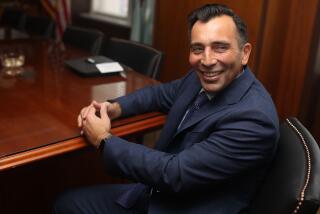Stench of CalPERS’ financial scandal lingers
Whether we’re talking about corporate affairs or home ec, it’s a fundamental fact that housecleaning doesn’t work unless it’s thorough. Leave the smallest task undone, and the rats and bugs come swarming back.
So the question to ask about the financial scandal at CalPERS is this: Has the place been sufficiently scrubbed clean?
The affair is centered on placement agents, the middlemen hired by Wall Street firms and other money managers to snag investment capital from institutional investors.
The California Public Employees’ Retirement System, the largest public pension fund in the country with $225 billion in assets, is one of the biggest targets out there.
CalPERS has had a particular problem with a placement agent named Alfred Villalobos, a former member of the CalPERS board who hired himself out to several big investment firms, plainly on the expectation that he would use his connections to get them business. According to a lawsuit filed last year by the state attorney general’s office, Villalobos made $47 million from 2005 to 2009 by getting CalPERS to invest $4.87 billion with his clients.
The AG’s lawsuit and a just-released report on the Villalobos affair prepared for CalPERS by the Washington law firm Steptoe & Johnson paint a picture of corruption, moral corrosion and board-level inattention staggering in scale.
CalPERS directors and officials accepted gifts, cut secret deals and tried to subvert professional standards to serve Villalobos’ clients. Some of the ugliest behavior is laid to Fred Buenrostro, a Villalobos crony who served as CalPERS chief executive from 2002 to 2008, during which period Villalobos allegedly paid for his travel, first-class accommodations and even part of his wedding. After leaving CalPERS, Buenrostro took a job with Villalobos.
No criminal charges have been filed, but investigations are ongoing.
Perhaps the saddest aspect of the case is that it could be used as a pretext by unscrupulous politicians to attack public employee pensions generally. Already the backers of a ballot initiative to ratchet down retirement benefits are using it as an argument in support, which sounds a lot like blaming a house for becoming the target of an arsonist. The employees are the victims here.
CalPERS has responded to these disclosures by tightening up its rules regarding placement agents and board members. It successfully sponsored a law requiring placement agents to register with the state like any other lobbyists, set up an ethics hotline for employees and placed new restrictions on contacts between board members and investment staff. These items address abuses uncovered in the Villalobos scandal.
Are they enough? The scandal developed under the nose of the 12-member CalPERS board (and implicated some of those members, all now ex-members), so they can’t be absolved of responsibility. The Steptoe report and other sources say Villalobos, Buenrostro and others took steps to keep their machinations outside the view of most of the board, meeting out of state or at a Sacramento hotel that was on unions’ do-not-patronize list, ensuring that the board’s union members wouldn’t stumble upon them.
“Ninety percent of what was in the [Steptoe] report was news to everyone,” CalPERS board President Rob Feckner, who has served on the board since 1999, told me. Should it have come like such a bolt from the blue? Buenrostro’s favoritism toward certain investment managers was apparently so well-known among CalPERS staff that they had a name for them: “Friends of Fred.”
The staff eventually complained to Feckner, who started the ball rolling to fire Buenrostro by 2008. Still, when Buenrostro announced his retirement that April, Feckner lauded him fulsomely for his record of public service while failing to mention the ugly truth. Plainly, the public deserved to know the facts.
Taxpayers and public employees also deserve a stronger board. Currently, it comprises three state officials serving ex officio and nine members representing state agencies and other stakeholders such as retirees and employees.
“There’s no institution in the state that requires a stronger board than CalPERS,” said Robert Fellmeth, an expert on public administration at the University of San Diego. “But it has just the opposite.”
He recommends that members be appointed by the governor, with the approval of the Legislature. While that might not guarantee an aggressive, independent board that wouldn’t let a scandal slip by unnoticed, a change is surely worth debating.
What the scandal leaves unclear about placement agents is why investment firms need them, other than to exert improper influence on institutional investors. Consider what the Steptoe report says about Los Angeles-based Aurora Capital Group, which has been chaired by Gerald Parsky, a well-connected lawyer and investor who was appointed by Gov. Arnold Schwarzenegger to two high-level citizens’ commissions, including as chair of a tax-revision panel that recommended cutting rates on the wealthy and saddling up on the middle and working classes.
Aurora, which became a Villalobos client, was the focus of especially energetic internal lobbying by Buenrostro. The report says he kept bugging the CalPERS investment staff to invest more with Aurora, noting the “substantial political benefits that might come to CalPERS” (Steptoe’s words) from playing ball with a firm so close to the governor.
In a written statement to me, Aurora played dumb. The firm says it “did not work with Mr. Buenrostro on any investments” and has no knowledge of what he discussed with the CalPERS staff. That makes it sound, implausibly, as though Buenrostro injected himself entirely on his own initiative into investment decisions on Aurora, violating CalPERS practice and proprieties. Steptoe says the investment staff ignored Buenrostro and evaluated the investment on its merits; CalPERS has earned about 17% on the Aurora investment from its inception in September 2007 through June 2010.
Yet if Aurora’s performance is so good, that only raises more questions about why the firm needed to employ Villalobos as an intermediary. Curiously, Aurora signed its contract with Villalobos in April 2008 — more than six months after CalPERS committed to investing $400 million with the firm — but agreed to pay him a $4-million fee for that transaction anyway, according to the state’s suit. Aurora refused to respond to my question about that aspect of the deal.
One other point: Last year, CalPERS persuaded four big investment firms to reduce their fees by $215 million because of the problems with placement agents. Aurora wasn’t among them. When Aurora asked CalPERS to sign up for a new investment fund it was opening, CalPERS says it turned the offer down. That sounds like progress.
CalPERS lately has had more than its share of problems — lousy investments, executive turnover, ethical misjudgments galore. Dispelling the stench of the placement agent scandal could take years. The nation’s largest public pension fund is a leader in holding corporate America to high governance standards. If CalPERS can’t meet those standards itself, it’s time for the board members in charge to make way for people who can do better.
Michael Hiltzik’s column appears Sundays and Wednesdays. Reach him at mhiltzik@latimes.com, read past columns at latimes.com/hiltzik, check out facebook.com/hiltzik and follow @latimeshiltzik on Twitter.







